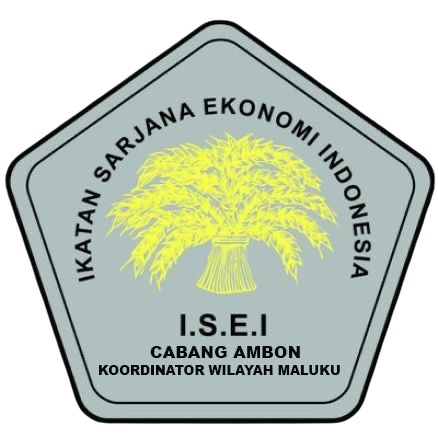DAMPAK PENERAPAN NET ZERO EMISSION TERHADAP PERTUMBUHAN FISKAL INDONESIA
Impact of Net Zero Emission to Indonesia Fiscal Growth
Abstract
This study has three objectives. First, to estimate the factors affecting the level of energy consumption, especially coal subject to carbon tax. Second, to project the amount of carbon emissions from 2020 to the year of carbon tax implementation (2025) using the Vector Error Correction Model (VECM). Third, to calculate the potential government revenue from the implementation of carbon tax starting from the year of carbon tax implementation (2025) until 2050. This study uses panel data of 33 provinces in Indonesia from 2021 to 2022 and time series data of Indonesia from 1990 to 2020. Research results from Indonesian panel data show that Gross Regional Domestic Product (GRDP) and GRDP per capita have a significant positive influence. The VECM analysis projects that the amount of CO₂ carbon emissions moves dynamically in the 2021 to 2025 time series. The results are then used in the projection of government revenue for the next 25 years with potential government revenue through carbon tax amounting to 6.6 trillion rupiah.
Downloads
References
Adam, S., Delestre, I., Levell, P., & Miller, H. (2022). Tax policies to reduce carbon emissions. Fiscal Studies, 43(3), 235–263. https://doi.org/10.1111/1475-5890.12308
Asumadu-Sarkodie, S., & Owusu, P. A. (2017). The causal nexus between energy use, carbon dioxide emissions, and macroeconomic variables in Ghana. Energy Sources, Part B: Economics, Planning and Policy, 12(6), 533–546. https://doi.org/10.1080/15567249.2016.1225134
Bekun, F. V., Alola, A. A., & Sarkodie, S. A. (2019). Toward a sustainable environment: Nexus between CO2 emissions, resource rent, renewable and nonrenewable energy in 16-EU countries. Science of the Total Environment, 657, 1023–1029. https://doi.org/10.1016/j.scitotenv.2018.12.104
Bilan, Y., Streimikiene, D., Vasylieva, T., Lyulyov, O., Pimonenko, T., & Pavlyk, A. (2019). Linking between renewable energy, CO2 emissions, and economic growth: Challenges for candidates and potential candidates for the EU membership. Sustainability (Switzerland), 11(6), 1–16. https://doi.org/10.3390/su11061528
Climate Change Performance Index. (2023). Updated Indonesian NDC is only provisional. https://ccpi.org/country/idn/. Diakses pada 12 Agustus 2023.
Elliott, J., & Fullerton, D. (2014). Can a unilateral carbon tax reduce emissions elsewhere. Resource and Energy Economics, 36(1), 6–21. https://doi.org/10.1016/j.reseneeco.2013.11.003
Galinato, G. I., & Yoder, J. K. (2010). An integrated tax-subsidy policy for carbon emission reduction. Resource and Energy Economics, 32(3), 310–326. https://doi.org/10.1016/j.reseneeco.2009.10.001
International Energy Agency. (2021). Pathway to critical and formidable goal of net-zero emissions by 2050 is narrow but brings huge benefits, according to IEA special report. https://www.iea.org/news/pathway-to-critical-and-formidable-goal-of-net-zero-emissions-by-2050-is-narrow-but-brings-huge-benefits. Diakses pada 12 Agustus 2023.
Hao, L. N., Umar, M., Khan, Z., & Ali, W. (2021). Green growth and low carbon emission in G7 countries: How critical the network of environmental taxes, renewable energy and human capital is. Science of the Total Environment, 752, 141853. https://doi.org/10.1016/j.scitotenv.2020.141853
Kaika, D., & Zervas, E. (2013). The Environmental Kuznets Curve (EKC) theory-Part A: Concept, causes and the CO2 emissions case. Energy Policy, 62, 1392–1402. https://doi.org/10.1016/j.enpol.2013.07.131
Liddle, B. (2015). What are the carbon emissions elasticities for income and population? Bridging STIRPAT and EKC via robust heterogeneous panel estimates. Global Environmental Change, 31, 62–73. https://doi.org/10.1016/j.gloenvcha.2014.10.016
Lin, B., & Li, X. (2011). The effect of carbon tax on per capita CO2 emissions. Energy Policy, 39(9), 5137–5146. https://doi.org/10.1016/j.enpol.2011.05.050
Mahalik, M. K., Mallick, H., & Padhan, H. (2021). Do educational levels influence the environmental quality? The role of renewable and non-renewable energy demand in selected BRICS countries with a new policy perspective. Renewable Energy, 164, 419–432. https://doi.org/10.1016/j.renene.2020.09.090
Mehmood, U. (2021). Contribution of renewable energy towards environmental quality: The role of education to achieve sustainable development goals in G11 countries. Renewable Energy, 178, 600–607. https://doi.org/10.1016/j.renene.2021.06.118
Metcalf, G. E. (2009). Designing a carbon tax to reduce U.S. greenhouse gas emissions. Review of Environmental Economics and Policy, 3(1), 63–83. https://doi.org/10.1093/reep/ren015
Murad, M. W., Abdullah, A., Boyle, S., & Amaro, C. R. (2015). Forecasting carbon emission and industrial production using VECM: The case of Bangladesh. The Journal of Developing Areas, 49(6), 75–88. https://doi.org/10.1353/jda.2015.0103
Özbay, F., & Duyar, I. (2022). Exploring the role of education on environmental quality and renewable energy: Do education levels really matter. Current Research in Environmental Sustainability, 4(August). https://doi.org/10.1016/j.crsust.2022.100185
Pojok Iklim oleh Kementerian Lingkungan Hidup dan Kehutanan. (2021). Mari Kita Membaca Climate Change Performance Index 2021: Bagaimana Posisi Indonesia. http://pojokiklim.menlhk.go.id/read/mari-kita-membaca-climate-change-performance-index-2021-bagaimana-posisi-indonesia. Diakses pada 12 Agustus 2023.
Pratama, B. A., Ramadhani, M. A., Lubis, P. M., & Firmansyah, A. (2022). Implementasi Pajak Karbon Di Indonesia: Potensi Penerimaan Negara Dan Penurunan Jumlah Emisi Karbon. Jurnal Pajak Indonesia (Indonesian Tax Review), 6(2), 368–374. https://doi.org/10.31092/jpi.v6i2.1827
Presiden Republik Indonesia. (2021). Undang-Undang Nomor 98 Tahun 2021 Tentang Penyelenggaraan Nilai Ekonomi Karbon untuk Pencapaian Target Kontribusi yang Ditetapkan Secara Nasional dan Pengendalian Emisi Gas Rumah Kaca dalam Pembangunan Nasional, pp. 1–68.
Presiden Republik Indonesia. (2020). Peraturan Presiden Republik Indonesia Nomor 18 Tahun 2020 Tentang Rencana Pembangunan Jangka Menengah Nasional 2020-2024. Sekretariat Presiden Republik Indonesia, 1–7.
Presiden Republik Indonesia. (2021). Undang-Undang Nomor 7 Tahun 2021 Tentang Harmonisasi Peraturan Perpajakan. 1–119.
Purwanti, T. (2022). Pajak Karbon Ditunda Sampai 2025. https://www.cnbcindonesia.com/news/20221013175437-4-379582/pajak-karbon-ditunda-sampai-2025. Diakses pada 12 Agustus 2023.
Sadorsky, P. (2014). The effect of urbanization on CO2 emissions in emerging economies. Energy Economics, 41, 147–153. https://doi.org/10.1016/j.eneco.2013.11.007
Saputra, A. I. (2021). Pajak Karbon Sebagai Sumber Penerimaan Negara Dan Sistem Pemungutannya. Jurnal Anggaran Dan Keuangan Negara Indonesia (AKURASI), 3(1), 56–71. https://doi.org/10.33827/akurasi2021.vol3.iss1.art96
Sisodia, G. S., Sah, H. K., Kratou, H., Mohnot, R., Ibanez, A., & Gupta, B. (2023). The Long-Run Effect of Carbon Emission and Economic Growth in European Countries: A Computational Analysis through Vector Error Correction Model. International Journal of Energy Economics and Policy, 13(3), 271–278. https://doi.org/10.32479/ijeep.13942
Sumner, J., Bird, L., & Dobos, H. (2011). Carbon taxes: A review of experience and policy design considerations. Climate Policy, 11(2), 922–943. https://doi.org/10.3763/cpol.2010.0093
Tiawon, H., Irawan, & Miar. (2020). Empirical Assessment for Driving Forces of CO2 Emissions : Application of STIRPART Model on the Leading ASEAN Countries. Contemporary Economics, 14(4), 453–465. https://doi.org/10.5709/ce.1897-9254.418
Tol, R. S. J. (2005). The marginal damage costs of carbon dioxide emissions: An assessment of the uncertainties. Energy Policy, 33(16), 2064–2074. https://doi.org/10.1016/j.enpol.2004.04.002
United Nations. (2023). For a livable climate: Net-zero commitments must be backed by credible action. https://www.un.org/en/climatechange/net-zero-coalition#. Diakses pada 12 Agustus 2023.
United Nations. (2023). What Is Climate Change. https://www.un.org/en/climatechange/what-is-climate-change. Diakses Pada 12 Agustus 2023.
Vidyarthi, H. (2013). Energy consumption, carbon emissions and economic growth in India. World Journal of Science, Technology and Sustainable Development, 10(4), 278–287. https://doi.org/10.1108/wjstsd-07-2013-0024
World Bank. (2020). Pricing Carbon. https://www.worldbank.org/en/programs/pricing-carbon. Diakses pada 13 Agustus 2023.
Yusuf, A. A., & Resosudarmo, B. P. (2015). On the distributional impact of a carbon tax in developing countries: the case of Indonesia. Environmental Economics and Policy Studies, 17(1), 131–156. https://doi.org/10.1007/s10018-014-0093-y
Zaidi, S. A. H., Wei, Z., Gedikli, A., Zafar, M. W., Hou, F., & Iftikhar, Y. (2019). The impact of globalization, natural resources abundance, and human capital on financial development: Evidence from thirty-one OECD countries. Resources Policy, 64(July), 101476. https://doi.org/10.1016/j.resourpol.2019.101476
Zhao, X., & Luo, D. (2018). Forecasting fossil energy consumption structure toward low-carbon and sustainable economy in China: Evidence and policy responses. Energy Strategy Reviews, 22(December 2017), 303–312. https://doi.org/10.1016/j.esr.2018.10.003
Zhu, H. M., You, W. H., & Zeng, Z. fa. (2012). Urbanization and CO2 emissions: A semi-parametric panel data analysis. Economics Letters, 117(3), 848–850. https://doi.org/10.1016/j.econlet.2012.09.001
Copyright (c) 2024 Jurnal Cita Ekonomika

This work is licensed under a Creative Commons Attribution-NonCommercial 4.0 International License.










